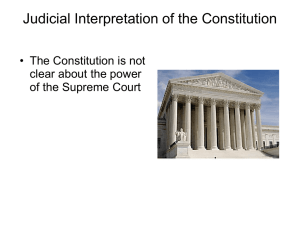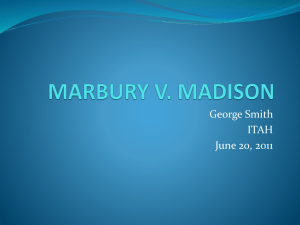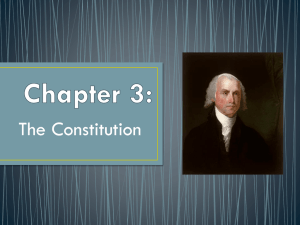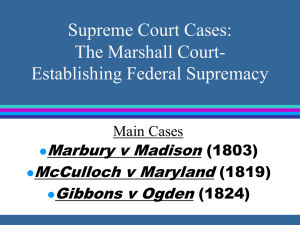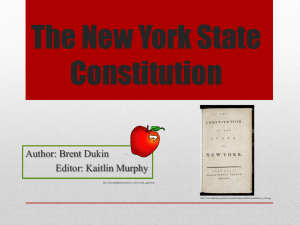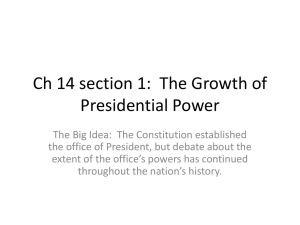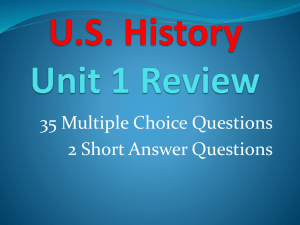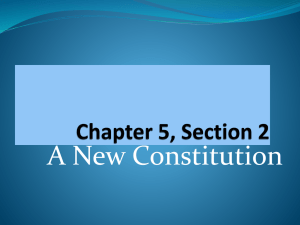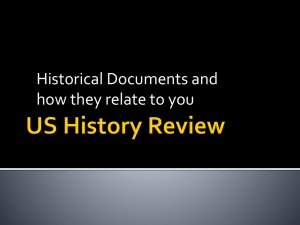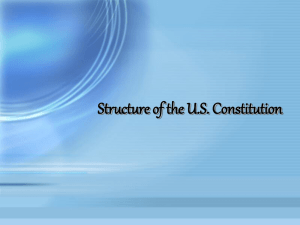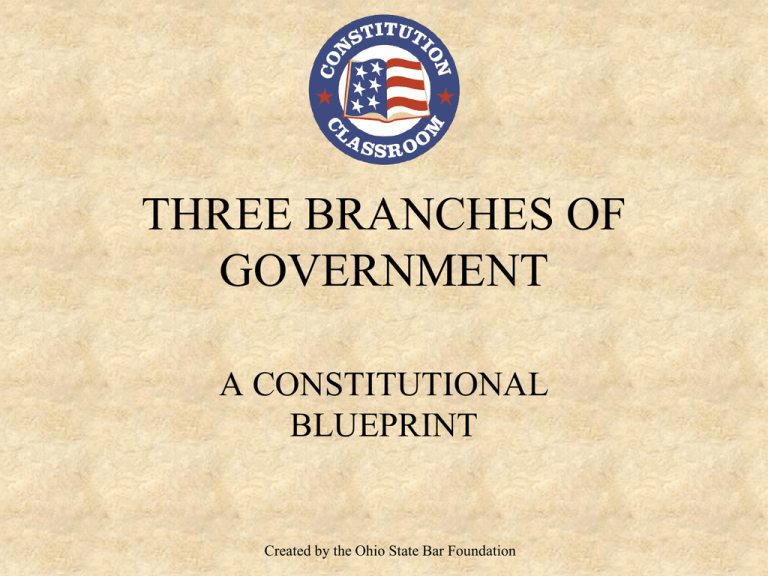
THREE BRANCHES OF
GOVERNMENT
A CONSTITUTIONAL
BLUEPRINT
Created by the Ohio State Bar Foundation
Three Branches of Government
Division of Labor Means Division of Power
Created by the Ohio State Bar Foundation
Background Story
John Adams Influence
• Limit government
powers
• Separate powers
• Protect individual rights
• Do not let government
violate or abuse
Adams
Background Story
• Wrote Constitution of
Massachusetts
• Used as model for U.S.
Constitution
• Described three branches of
government in opening three
articles
Background Story
• The Legislative Branch
makes laws
• The Executive Branch
carries out the laws
• The Judicial Branch
interprets the laws
Legislative Branch- The Senate and
House of Representatives
• Controls purse strings
• Approves budget
• Oversees commerce
(trade and business)
Legislative Branch- The Senate and
House of Representatives
• Can declare war
• Can impeach
• Writes, debates, passes
bills into law
Executive Branch
• Makes treaties
• Appoints judges
• Is Commander-in-Chief
Executive Branch
• Suggests budget ideas
• Can veto a bill
• Enforces this country’s
laws
Judicial Branch
• Decides arguments
about the meaning of
laws
• Rules on how a law
should be applied
Judicial Branch
• Decides when
constitution is violated
• Decides outcome when
executive and legislative
branch disagree about
laws that have been
passed
Outcome of Division of Labor
• A form of job sharing
• A check of powers
• A balance of
responsibilities
• A prevention of
dangerous power grabs
by those who govern
Checks and Balances:
Legislative Check of Executive
• Can override
presidential vetoes
• Has power of the purse
strings
• Can impeach president
• Approves treaties and
presidential
appointments
Checks and Balances:
Legislative Check of Judicial
• Creates lower courts
• Can impeach judges
• Approves appointments
of judges
Checks and Balances:
Executive Check of Legislative
• Veto legislation
• Call special sessions of
Congress
• Recommend legislation
• Can appeal to the people
concerning legislation
Checks and Balances:
Executive Check of Judicial
• Appoints Supreme
Court judges
• Appoints federal judges
Checks and Balances:
Judicial Check of Executive
• Free from controls of
executive once
appointed
• Can judge the
constitutionality of
executive actions
Checks and Balances:
Judicial Check of Legislative
• Can judge legislative
acts to be
unconstitutional
Additional Resources
• Three Ring Government
– Schoolhouse Rock
THREE BRANCHES OF
GOVERNMENT
A CONSTITUTIONAL
BLUEPRINT
Created by the Ohio State Bar Foundation
Bill Me For My Idea - Making Laws
A Constitutional Blueprint
Created by the Ohio State Bar Foundation
Background Story
• U.S. Congress met for first
time on March 4, 1789
• Set up rules and procedures
• Determined the roles of its
officers- Speaker of the
House and President of the
Senate
Background Story
• First law passed- Oath
of Office
• Created Departments of
State, War, Treasury,
and temporary post
office
• Established a federal
judiciary
Background Story
• Provided for lighthouses
and expenses to negotiate
with Native American
tribes
• Failed to locate a capital
Background Story
• Congressmen paid $6 a
day for their work
• During the 1790s onethird of the Senate
resigned- too much of a
hardship
Background Story
• “Scarcely a day passes
without some striking
evidence of the delays
and perplexities
springing merely from
the want of precedent.”
-James Madison
• A system where anyone’s
idea can become law
eventually evolved.
Madison
Steps in Making a Law
• Start with an idea
• Introduce the idea as a bill
– Write up and sponsor
– Place in hopper
– Assign a number
Steps in Making a Law
• Goes to an appropriate
committee for study
• Is sent to full house or
senate
• Is voted on
– Viva Voce
– Division
– Recorded
Steps in Making a Law
• Goes through same
procedure in other
chamber
• Goes to a conference
committee if differences
exist
Steps in Making a Law
Once delivered to
president, the bill
• Is signed
• Is vetoed (Sent back to
Congress where it needs
a 2/3 majority vote to
override veto)
• Becomes law without his
signature (pocket veto)
Steps in Making a Law
Becomes a law
• Once president signs
• When president uses a
pocket veto
• When Congress
overrides a veto
Outcome
• Congress has passed
more than 20,000 laws
• 200-600 have been
passed during each of its
112 two-year sessions
• House may debate and
vote on a bill in a single
day- Senate may take
longer
Outcome
House set up to represent closely
the will of the people:
• Re-election every two years
• Represents smaller group of
people
• Often votes on a bill because
of its impact on district
Outcome
Senate set up to look at long
term effects
•
Re-election every six years
•
Represents an entire state
•
Often votes based on the
interests of an entire nation
Outcome
• Debate and compromise
are at the heart of bills
becoming laws
• Two unique chambers,
the House and the
Senate, are another form
of “checks and
balances”
Additional Resources
• Just A Bill –
Schoolhouse Rock
THREE BRANCHES OF
GOVERNMENT
A CONSTITUTIONAL
BLUEPRINT
Created by the Ohio State Bar Foundation
The Fourth Branch - You the Voter
A Constitutional Blueprint
Created by the Ohio State Bar Foundation
Background Story
• Voting is not explicitly
guaranteed
• Constitution only
describes how to elect
• Constitution does ban
discrimination
Background Story
• States and local
governments control
basic voting rights
• Over 13,000
jurisdictions
• Only free, white males
used to vote
Background Story
• Women got the right to vote in
1920 – 19th Amendment
• Any citizen over 18 can now
vote – 26th Amendment
• States determine how one votes
Background Story
• In 2000 only 51% voted
• Gore would have won
in 2000 with a change
of only 279 votes in
Florida
• Voting makes a
difference- Texas
statehood determined by
only one vote
Background Story
• Amendments make a difference:
– African-Americans (15th Amendment)
– Women (19th Amendment)
– 18-year-olds (26th Amendment)
Background Story
• You can campaign,
volunteer, register voters,
and state your opinion
even if you are not old
enough to vote
Outcome
• Voting is essential to
democracy
• The “Fourth Branch”
(voters) determines
whether the other three
branches work
Outcome
• Voters give consent to
be governed
• Voters have the right
(referendum) to repeal
laws
• Voters are the ultimate
power in checks and
balance system
THREE BRANCHES OF
GOVERNMENT
A CONSTITUTIONAL
BLUEPRINT
Created by the Ohio State Bar Foundation
Separation of Powers
Relevant Case
United States v. Nixon (1974)
Created by the Ohio State Bar Foundation
Background Story
• Separation of Powers
was challenged in 1972
• Five men illegally broke
into Democratic
National Headquarters
(Watergate complex)
• Men were connected to
Nixon’s re-election
committee
Background Story
• Nixon and staff covered
up the break-in (also an
illegal act)
• Senate Watergate
Committee conducted
hearings
Background Story
• Evidence mounted
against the president
• Nixon recorded
conversations with his
staff
• Committee wanted to
know if conversations
tied the president to
break-in and cover-up
Background Story
• Tapes were subpoenaed
• President filed a motion
against the subpoena
• President claimed
executive privilege
• Conflict reached the
Supreme Court
Legal Problem
Can a president, as he exercises presidential authority,
keep conversations and information confidential?
Arguments for the Special Prosecutor
• Tapes might have
information about
break-in and cover-up
• White House tapes are
only source for that
information
Arguments for the Special Prosecutor
• Executive privilege is not
absolute
• Scope of executive privilege
should be determined by the
courts, not the president
• President cannot withhold
information essential to a
criminal investigation
Arguments for the President
• Confidential
conversations are not
for public view
• Executive privilege is
absolute under the
separation of powers
doctrine
• Judicial Branch cannot
subpoena tapes
Outcome
• The Supreme Court (9-0)
ruled that Nixon had to
comply to the subpoena
• Separation of powers has
limits
Outcome
• Limits are determined
by the court, not the
president
• Tapes’ information did
not directly relate to
president’s authority
granted by Constitution
Outcome
• Executive privilege can
not block information
relevant to a criminal
prosecution
• President must obey
lawful court orders just
like any other citizen
THREE BRANCHES OF
GOVERNMENT
A CONSTITUTIONAL
BLUEPRINT
Created by the Ohio State Bar Foundation
Separation of Powers
Historical Case
Marbury v. Madison (1803)
Created by the Ohio State Bar Foundation
Background Story
• The Constitution was
only 16 years old
• A constitutional feud
between outgoing
President John Adams
and incoming President
Thomas Jefferson
occurred
Background Story
• Founding Fathers never
said who had final say
about constitutional issues
• Lame Duck President
John Adams appointed 58
people to government
jobs, including William
Marbury
Background Story
• Appointees could not
start jobs without signed
papers in hand from
Adams
• Marbury’s papers were
not delivered before
Jefferson took office
Background Story
• Jefferson’s Secretary of
State, James Madison,
was told not to deliver
papers to Marbury
• Jefferson wanted to
appoint someone else
Marbury
Madison
Background Story
• Marbury sued Madison
• Marbury went to the
Supreme Court
• Marbury wanted to
force Madison to deliver
the paperwork
Background Story
• Marbury would have
already been on the job
if papers had been
delivered on time
• Marbury thought he
deserved the job
Legal Problem
• Whose job was it?
• Could Supreme Court
order president to do
something?
• Who would have final
say?
Marbury’s Arguments
• He was legally appointed to the
job
• Jefferson could not undercut
Adams
• Congress’s Judiciary Act of
1789 (the establishment of a
judicial system) gave the
Supreme Court the power to tell
another branch of government
what to do
Madison’s Arguments
• Judiciary Act did not give
absolute power to the Supreme
Court
• Supreme Court cannot rule
since the suit should not have
been brought to it in the first
place
• The Court did not have the right
to tell Jefferson what to do
Outcome
• Marbury had the right to
appointment but never
got it
• Court ruled the
Judiciary Act of 1789
unconstitutional
• Congress cannot grant
powers, only the
Constitution can
Outcome
• Constitution did not
give the Supreme Court
these powers
• Supreme Court could
not force Jefferson’s
hand
Outcome
• Marbury v. Madison,
however, did establish a
precedent- legal
decision to serve as an
example in future cases
• Court has the right to
review congressional
laws
Outcome
• Court has the right to
review presidential acts
• Judicial review is
established
Outcome
• Constitution is supreme
law of the land
• Supreme Court has final
say over Constitution’s
meaning
Outcome
• Distinct separation of
powers is defined
• Neither Congress nor
president can rule on
Constitution
• Supreme Court only can
rule on constitutional
meaning
Outcome
• Jefferson won the battle
• Supreme Court won
the war
Additional Resources
•
•
•
The Supreme Court – Episode 1 Excerpt, PBS
Marbury v. Madison, Part 1 – Thinkwell’s American
Government
Marbury v. Madison, Part 2 – Thinkwell’s American
Government
THREE BRANCHES OF
GOVERNMENT
A CONSTITUTIONAL
BLUEPRINT
Created by the Ohio State Bar Foundation
Do’s and Don’ts For Teens
A Trickle Down Effect
Created by the Ohio State Bar Foundation
Background Story
• One in five Americans can name all five members of
Homer Simpson’s family
• Only one in 1,000 can name First Amendment’s five
basic freedoms
Background Story
• One in five think First Amendment protects right to
own a pet
• One in 17 think it guarantees the right to drive a car
Background Story
• In a trickle down way the Constitution does have a
say about pet ownership and driving privileges
Background Story
• It provides governing
law for entire country
• It states government
responsibilities and
limitations
• It defines individual
rights and group rights
Background Story
• It influences everyday routines:
– Texting or talking on a cell phone
– Using computers
– Going to church, school, or the corner drugstore
– Crossing the street
Background Story
• The Constitution
establishes in an indirect
way the guidelines for
most of our really
important activities
Outcome
• What laws may affect
what I do and how I do
it?
• What’s in it for me?
Areas Defined and Limited by Legislation
Internet Usage
Teen Pregnancy
Parental
Notification
regarding
contraceptives
Music Censorship
Minimum Wages
Tagging
Vandalism
Egging
Spray painting
Bullying
Drug Use
Alcohol
Use/Drinking Age
Sex/Dating
Teen Smoking
Work
Hiring/Firing
Fighting
Shoplifting
Video Games
Movies/T.V.
Being tried as an
adult-When? What
for?
Loitering
Runaways
Auto Ownership
Insurance
Motorcycle Riding
Driving
Legal Age to Leave
Home
Staying in School/
Graduation
Teen Marriage
Sexting/Texting
Gangs
Curfews
THREE BRANCHES OF
GOVERNMENT
A CONSTITUTIONAL
BLUEPRINT
Created by the Ohio State Bar Foundation
Present Day Realities
Judging Separation of Powers
Created by the Ohio State Bar Foundation
Background Story
The Constitution… meant that its coordinate
branches should be checks on each other. But the
opinion which gives to the judges the right to decide
what laws are constitutional and what not, not only
for themselves in their own sphere of action but for
the Legislature and Executive also in their spheres,
would make the Judiciary a despotic branch.
– Thomas Jefferson, 1804
Background Story
• The Branches still clash over
their powers
• The Branches are balanced so
that no one branch becomes
too powerful
• The Founding Fathers wanted
us always to challenge who
has the power and how it is
being used
Asking Questions About the Three
Branches of Government
• Is it good for only the
Supreme Court to
decide what is
constitutional?
• Why is the judgment of
constitutionality in the
hands of the Supreme
Court alone? Legislators
and presidents take an
oath to uphold the
Constitution also.
Asking Questions About the Three
Branches of Government
• What is an activist
judge?
• Is it good or bad to be
one?
Asking Questions About the Three
Branches of Government
• How can the U.S.
Supreme Court decide
who won an election as
it effectively did when it
decided Bush v. Gore in
2000?
Asking Questions About the Three
Branches of Government
• Why can something be
declared constitutional
and 50 years later be
declared
unconstitutional?
• Does the Constitution
really have absolute
meaning? Is there ever
an absolute
interpretation?
Asking Questions About the Three
Branches of Government
• If Congress passes a law
that may be unconstitutional
but is not challenged in
court, don’t we have to obey
it no matter what?
• What could happen if the
Supreme Court’s rulings are
not obeyed? Has this ever
happened in our history?
Asking Questions About the Three
Branches of Government
• Are there issues about which
the Constitution is silent?
What might some of these
be? Immigration?
Marriage? Education?
Political parties? Age
discrimination?
• Who has the right to make
decisions about them?
Asking Questions About the Three
Branches of Government
• Has the Executive
Branch ever taken on
more power than was
given to it?
• Can a president have
more power in time of
war- even a continuing
war on terrorism?
Asking Questions About the Three
Branches of Government
• Is our government very
efficient? Aren’t checks
and balances a
hindrance at times?
• Do politics play too
much a part in running
all three branches of
government? Does
money?
Asking Questions About the Three
Branches of Government
• Should a legislator vote
what he thinks is right? Or,
should he always vote the
majority’s wishes?
• How can our Constitution
still be relevant today?
Hasn’t the world changed
too much?
Asking Questions About the Three
Branches of Government
• Can our government
and our Constitution
survive if only one out
of two people, at best,
vote?
• Or, do we want only the
willing to determine our
future?
Asking Questions About the Three
Branches of Government
• Would you ever see yourself as an elected official?
Why or why not?

